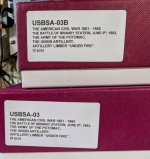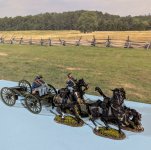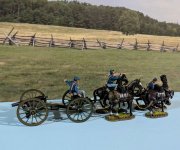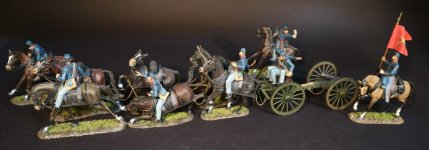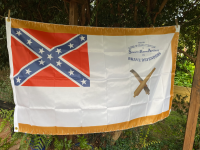- Joined
- Feb 2, 2011
- Messages
- 2,383
THE AMERICAN CIVIL WAR
THE BATTLE OF BRANDY STATION, JUNE 9th, 1863
THE ARMY OF THE POTOMAC, CAVALRY CORPS.
The high ground on the farm of Richard Cunningham served as wing commander Brig. Gen. John Buford’s command post for much of the battle. Cavalry corps commander Alfred Pleasonton also observed the fighting from this area. Custer, an aide to Pleasonton was spotted here during the afternoon phase of the engagement.
Daniel Oakey was an officer in the 2nd Massachusetts Infantry, which made up Brig. Gen. Adelbert Ames’ demi-brigade that supported Pleasonton’s horse soldiers.
“Having nothing to do as yet but smoke our pipes, we lolled on the grass and studied our cavalry friends”, Oakey recalled. “Custer was the most striking of the group with…his long hair, and spirited manner. He seemed to enjoy the shelling, and appeared to beam all over, almost dancing with excitement.”
When Buford called on the Bay Staters to dislodge elements of Brig. Gen. W.H.F. “Rooney” Lee’s brigade at a stonewall at the knoll’s western base, Oakey wrote that “Custer showed much interest” in accompanying them and “evidently would have enjoyed going with us.” The young officer, however, remained behind with Pleasonton.
THE UNION ARTILLERY
The Union artillery was organized into Heavy Artillery and Field Artillery. The latter was also divided into Light Artillery and Horse Artillery.
During the Civil War the tendency was to concentrate close support at infantry or cavalry division level, with several batteries concentrated within an artillery brigade, under the command of a senior officer.
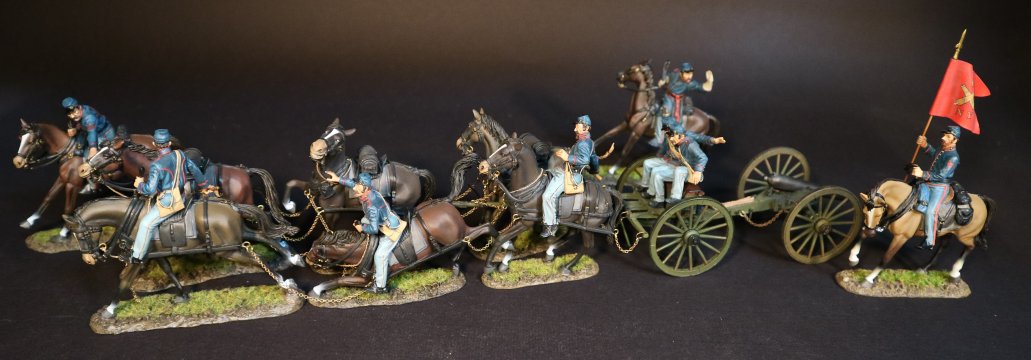
At Brandy Station, both sides had batteries of horse artillery. Confederate horse artillery, due to the South having trouble supplying horse for artillery teams as well as horses to ride, meant that Confederate batteries were standardized at four field pieces each, which was two less than their Union counterparts.
By 1863, most Union Horse Artillery Batteries consisted of six 3-in. Ordnance Rifles. These guns were comparatively light, accurate and safe.
The most technically proficient and best drilled of the arms in the Union Army was the Artillery.
Union Artillery limbers for the Field Artillery, would often be able to have 6 horse teams.

USBSA-03
THE AMERICAN CIVIL WAR 1861 - 1865
THE BATTLE OF BRANDY STATION, JUNE 9th, 1863,
THE ARMY OF THE POTOMAC,
THE UNION ARTILLERY,
ARTILLERY LIMBER “UNDER FIRE”
PLEASE NOTE EXTENSION SETS WILL BE AVAILABLE IN A FEW MONTHS.
THE BATTLE OF BRANDY STATION, JUNE 9th, 1863
THE ARMY OF THE POTOMAC, CAVALRY CORPS.
The high ground on the farm of Richard Cunningham served as wing commander Brig. Gen. John Buford’s command post for much of the battle. Cavalry corps commander Alfred Pleasonton also observed the fighting from this area. Custer, an aide to Pleasonton was spotted here during the afternoon phase of the engagement.
Daniel Oakey was an officer in the 2nd Massachusetts Infantry, which made up Brig. Gen. Adelbert Ames’ demi-brigade that supported Pleasonton’s horse soldiers.
“Having nothing to do as yet but smoke our pipes, we lolled on the grass and studied our cavalry friends”, Oakey recalled. “Custer was the most striking of the group with…his long hair, and spirited manner. He seemed to enjoy the shelling, and appeared to beam all over, almost dancing with excitement.”
When Buford called on the Bay Staters to dislodge elements of Brig. Gen. W.H.F. “Rooney” Lee’s brigade at a stonewall at the knoll’s western base, Oakey wrote that “Custer showed much interest” in accompanying them and “evidently would have enjoyed going with us.” The young officer, however, remained behind with Pleasonton.
THE UNION ARTILLERY
The Union artillery was organized into Heavy Artillery and Field Artillery. The latter was also divided into Light Artillery and Horse Artillery.
During the Civil War the tendency was to concentrate close support at infantry or cavalry division level, with several batteries concentrated within an artillery brigade, under the command of a senior officer.

At Brandy Station, both sides had batteries of horse artillery. Confederate horse artillery, due to the South having trouble supplying horse for artillery teams as well as horses to ride, meant that Confederate batteries were standardized at four field pieces each, which was two less than their Union counterparts.
By 1863, most Union Horse Artillery Batteries consisted of six 3-in. Ordnance Rifles. These guns were comparatively light, accurate and safe.
The most technically proficient and best drilled of the arms in the Union Army was the Artillery.
Union Artillery limbers for the Field Artillery, would often be able to have 6 horse teams.

USBSA-03
THE AMERICAN CIVIL WAR 1861 - 1865
THE BATTLE OF BRANDY STATION, JUNE 9th, 1863,
THE ARMY OF THE POTOMAC,
THE UNION ARTILLERY,
ARTILLERY LIMBER “UNDER FIRE”
PLEASE NOTE EXTENSION SETS WILL BE AVAILABLE IN A FEW MONTHS.



